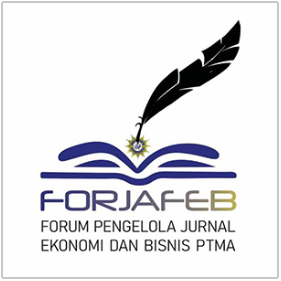Evaluating Capital Market Education to Enhance Investment Interest and Financial Inclusion: A Mixed Methods Aproach
Abstract
The year 2020 witnessed a resurgence of domestic retail investors in the Indonesian Capital Market, fueled by the COVID-19 pandemic. The national trend in stock investor growth shows a significant increase, whereas at Investment Gallery at the University of Technology Sumbawa, there has been a declining trend in percentage terms. The prevalence of fraudulent investment schemes, such as the Financial FEC, claiming 80,000 victims, underscores the pivotal role of the Investment Gallery at the University of Technology Sumbawa in the Sumbawa Regency The research aims to: 1) Identify the characteristics of the Investment Gallery of the University of Technology Sumbawa education participants, capital market education, investment knowledge, investment interest, and financial inclusion. 2) Analyze the impact of capital market education and investment knowledge, mediated by investment interest, on the financial inclusion of the Investment Gallery of the University of Technology Sumbawa education participants. 3) Explore the strategies and methods used in education by Investment Gallery of the University of Technology Sumbawa. This research utilizes a mixed-method approach, with primary data collected through questionnaires from 100 respondents and in-depth interviews with 6 selected respondents and Investment Gallery at the University of Technology Sumbawa stakeholders, along with secondary data from Investment Gallery at the University of Technology Sumbawa and other sources. The research findings indicate that the levels of capital market education, investment knowledge, investment interest, and financial inclusion are at a moderate level. The results of the Structural Equation Modeling (SEM) indicate that capital market education and investment knowledge do not have a direct or indirect influence on financial inclusion through investment interest. Furthermore, the efforts in capital market education by Investment Gallery at the University of Technology Sumbawa are not yet optimal, the use of social media for education is underutilized, and collaboration with government and campus and non-campus organizations has not been established.
References
Andreas, Riska, N., & Situmorang, M. (2014). The Influence of Motivation on Interest in Investing in the Capital Market with Investment Understanding and Age as Moderating Variables. JOM FEKOM, 1(2), 1-18.
Andriani, S., & Pohan, A. S. (2019). Student Stock Investment Interest. Jurnal Ekonomi dan Bisnis Indonesia, 04(01), 37-44. Anwar, K., & Amri. (2017). The Effect of Financial Inclusion on Indonesia's GDP. Jurnal Ilmiah Mahasiswa (JIM), 2(3), 454–462. Asri, M. (2013). Behavioral Finance. First Edition. BPFE-Yogyakarta. Azwar, S. (2012). Reliability and Validity. Yogyakarta: Pustaka Pelajar. Indonesia Stock Exchange. (2021). BEI 2021 Annual Report. Jakarta: PT. Bursa Efek Indonesia (BEI). Indonesia Stock Exchange. (2023). BEI Investment Gallery and Capital Market Community. URL: https://www.idx.co.id/id/produk/galeri-investasi-bei-komunitas-pasar-modal. Accessed February 19, 2023. Creswell, J. (2016). Research Design: Qualitative, Quantitative, and Mixed Methods Approaches (4th ed.). Sage Publications. California (US). Darmawan, A., & Japar, J. (2019). The Influence of Investment Knowledge, Minimum Capital, Capital Market Training, and Motivation on Investment Interest in the Capital Market (Study on Students at Feb University Muhammadiyah Purwokerto). Jurnal Neraca Fakultas Ekonomi dan Bisnis, 15(1), 1-13. Darmawan, A., Kurnia, K., & Rejeki, S. (2019). Investment Knowledge, Investment Motivation, Financial Literacy, and Family Environment: Their Influence on Investment Interest in the Capital Market. Jurnal Ilmiah Akuntansi dan Keuangan, 08(02), 44-56. Dewi, M.P., Tamansari, N., & Santini, N.M. (2020). The Influence of Capital Market Education on Risk Perception and Investment Interest of the Public. Jurnal KRISNA: Kumpulan Riset Akuntansi, Vol.12, 190-196. University of Technology Sumbawa Investment Gallery. (2022). Transaction and Investor Addition Report 2022. Sumbawa Regency: University of Technology Sumbawa Investment Gallery. Ghozali, I. (2014). Multivariate Analysis Application with SPSS Program. Undip Publishing Agency. Semarang. Kusmawati. (2011). The Influence of Motivation on Interest in Investing in the Capital Market with Investment Understanding and Age as Moderating Variables. Jurnal Ekonomi dan Informasi Akuntansi (Jenius), 1(2), 2303-1018. Indonesia Central Securities Depository. (2022). Indonesian Capital Market Statistics 2022. Jakarta: PT. Kustodian Sentral Efek Indonesia. Kutari, Y. (2023). OJK NTB Reveals 80 Thousand People Become Victims of Online Investment FEC. URL: https://lombokpost.jawapos.com/metropolis/1502961891/ojk-ntb-ungkap-80-ribu-orang-jadi-korban-investasi-online-fec. Accessed October 13, 2023. Marlin, K. (2020). The Effect of Investment, Return Perception, and Sharia Investment Motivation on the Indonesia Stock Exchange IAIN Batusangkar. Jurnal Ilmiah Indonesia, 5(6), 2541-0849. Mugo, E. (2016). Effect of Financial Literacy on Investment Decision Cooperative Societies Member in Nairobi. Dissertation. KCA University Dissertation Paper. Mulyadi. (2021). The Influence of the Indonesia Stock Exchange Investment Gallery, Minimum Capital, Investment, and Return Perception on Stock Investment Interest in the Capital Market. Undergraduate Thesis. University of Technology Sumbawa. Mursyidan, F.F. (2023). The Influence of Financial Literacy, Age, Return, and Income on Investment Behavior. Undergraduate Thesis. University of Lampung. Nisa, A., Aminatun, & Zulaika Luki. (2017). The Effect of Investment Understanding, Minimum Investment Capital, and Motivation on Student Interest in Investing in the Capital Market. Jurnal PETA, Vol. 2 No. 2. Purwanti, T. (2022). Amazing, BEI Holds 11 Thousand Education in 2022! URL: https://www.cnbcindonesia.com/market/20221230162255-17-401597/gokil-2022-bei-helat-11-ribu-edukasi-segini-pesertanya#:~:text=Sedikitnya%20kata%20Iman%2C%20BEI%20telah,8%20juta%20orang%20sepanjang%202022. Accessed February 19, 2023. Safryani, U., Aziz, A., & Triwahyuningtyas, N. (2020). Analysis of Financial Literacy, Financial Behavior, and Income on Investment Decisions. Jurnal Ilmiah Akuntansi Kesatuan, 3(2), 319-332. Umar, A.U.A.A.U.A., & Zuhri, S. (2019). The Influence of Benefits, Knowledge, and Education on Student Interest in Investing in the Sharia Capital Market (Case Study at IAIN Salatiga Students). Li Falah-Jurnal Studi Ekonomi Dan Bisnis Islam, 4(1), 129-138. Viana, E.D., Febrianti, F., & Dewi, F.R. (2019). Analysis of the Influence of Investment Knowledge, Capital Market Training, Minimum Investment, and Risk Perception on Student Interest in the Capital Market (Study at Pt Phintraco Sekuritas Branch Office Semarang). Jurnal Aktual Akuntansi Keuangan Bisnis Terapan, 2, 1-22. Wibowo, A. (2022). The Influence of Investment Knowledge, Capital Policy, Minimum Investment, and Capital Market Training on Student Interest in Investing (Case Study of FE Unesa Students Registered in FE Unesa Investment Gallery). Jurnal Ilmu Manajemen, Vol. 1:7. Widianto, B.F. (2021). The Influence of Investment Knowledge and Minimum Capital on Student Interest in Investing in the Sharia Capital Market (Case Study at UIN Maulana Malik Ibrahim Malang Sharia Investment Gallery). Undergraduate Thesis. UIN Maulana Malik Ibrahim Malang.DOI: 10.30595/ratio.v5i1.20298
Refbacks
- There are currently no refbacks.

This work is licensed under a Creative Commons Attribution 4.0 International License.
ISSN: 2746-0061
|

_001.png)












